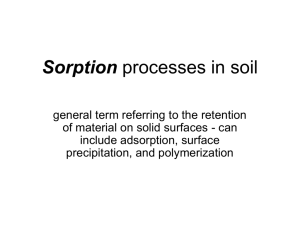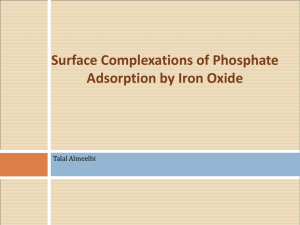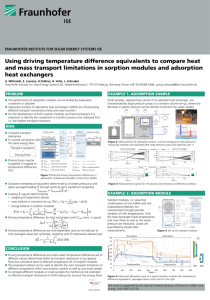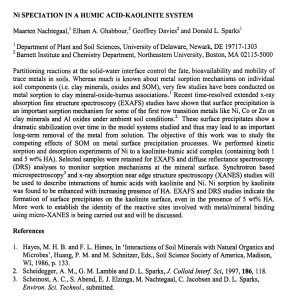been developed, take both factors into account. Recently we have... Our data suggest that changes in surface speciation are driven...
advertisement
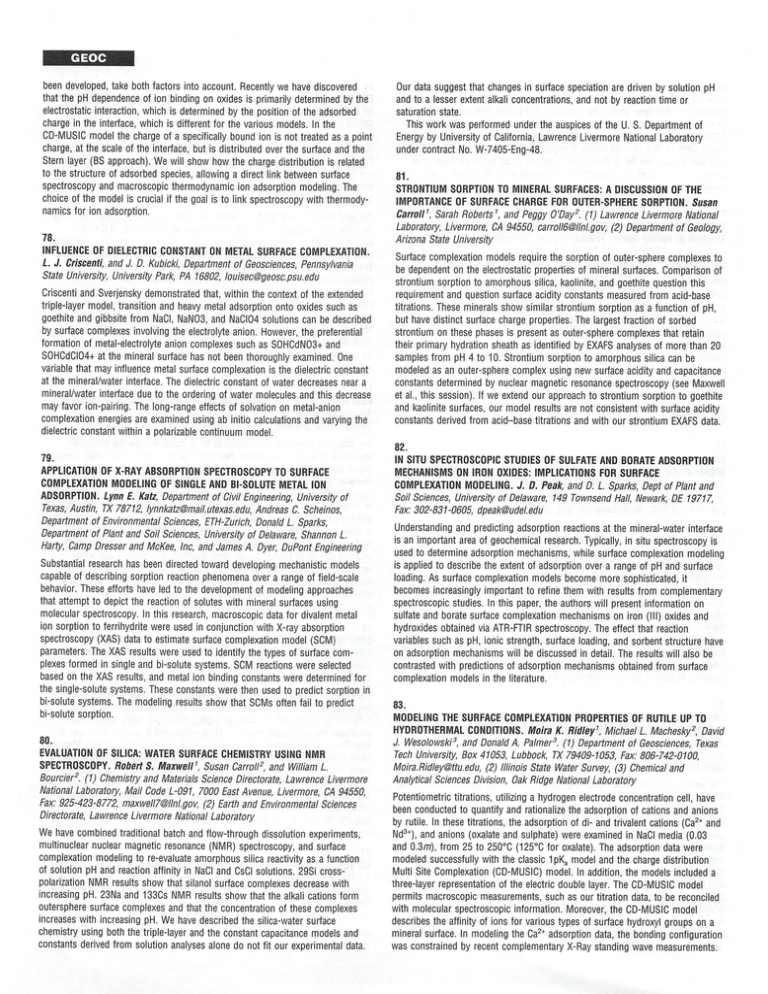
G E O C been developed, take both factors into account. Recently we have discovered that the pH dependence of ion binding on oxides is primarily determined by the electrostatic interaction, which is determined by the position of the adsorbed Our data suggest that changes in surface speciation are driven by solution pH and to a lesser extent alkali concentrations, and not by reaction time or charge in the interface, which is different for the various models. In the CD-MUSIC model the charge of a specifically bound ion is not treated as a point This work was performed under the auspices of the U. S. Department of Energy by University of California, Lawrence Livermore National Laboratory charge, at the scale of the interface, but is distributed over the surface and the under contract No. W-7405-Eng-48. saturation state. Stern layer (BS approach). We will show how the charge distribution is related to the structure of adsorbed species, allowing a direct link between surface spectroscopy and macroscopic thermodynamic ion adsorption modeling. The choice of the model is crucial if the goal is to link spectroscopy with thermody 81. STRONTIUM SORPTION TO MINERAL SURFACES: A DISCUSSION OF THE IMPORTANCE OF SURFACE CHARGE FOR OUTER-SPHERE SORPTION. Susan namics for ion adsorption. Carroll^ Sarah Roberts^ and Peggy O'Day^. (1) Lawrence Livermore National 78. Arizona State University Laboratory, Livermore, CA 94550, carroil6@ilnl.gov, (2) Department of Geology INFLUENCE OF DIELECTRIC CONSTANT ON METAL SURFACE COMPLEXATION. L. J. Criscenti, and J. D. Kubicki, Department of Geosciences, Pennsylvania State University, University Parl<, PA 16802, louisec@geosc.psu.edu Criscenti and Sverjensky demonstrated that, within the context of the extended triple-layer model, transition and heavy metal adsorption onto oxides such as goethite and gibbsite from NaCI, I\lal\l03, and NaCI04 solutions can be described by surface complexes involving the electrolyte anion. However, the preferential formation of metal-electrolyte anion complexes such as S0HCdl\l03+ and S0HCdCI04+ at the mineral surface has not been thoroughly examined. One variable that may influence metal surface complexation is the dielectric constant at the mineral/water interface. The dielectric constant of water decreases near a mineral/water interface due to the ordering of water molecules and this decrease may favor ion-pairing. The long-range effects of solvation on metal-anion complexation energies are examined using ab initio calculations and varying the dielectric constant within a polarizable continuum model. Surtace complexation models require the sorption of outer-sphere complexes to be dependent on the electrostatic properties of mineral surfaces. Comparison of strontium sorption to amorphous silica, kaolinite, and goethite question this requirement and question surface acidity constants measured from acid-base titrations. These minerals show similar strontium sorption as a function of pH, but have distinct surtace charge properties. The largest fraction of sorbed strontium on these phases is present as outer-sphere complexes that retain their primary hydration sheath as identified by EXAFS analyses of more than 20 samples from pH 4 to 10. Strontium sorption to amorphous silica can be modeled as an outer-sphere complex using new surface acidity and capacitance constants determined by nuclear magnetic resonance spectroscopy (see Maxwell et al., this session). If we extend our approach to strontium sorption to goethite and kaolinite surfaces, our model results are not consistent with surtace acidity constants denved from acid-base titrations and with our strontium EXAFS data. 82. 79. APPLICATION OF X-RAY ABSORPTION SPECTROSCOPY TO SURFACE COMPLEXATION MODELING OF SINGLE AND BI-SOLUTE METAL ION ADSORPTION. Lynn E. Katz, Department of Civil Engineering, University of Texas, Austin, TX 78712, lynnkatz@mall.utexas.edu, Andreas C. Schelnos, Department of Environmental Sciences, ETH-Zurlch, Donald L Sparks, Department of Plant and Soli Sciences, University of Delaware, Shannon L. Harty, Camp Dresser and McKee, inc, and James A. Dyer, DuPont Engineering Substantial research has been directed toward developing mechanistic models capable of describing sorption reaction phenomena over a range of field-scale behavior. These efforts have led to the development of modeling approaches that attempt to depict the reaction of solutes with mineral surfaces using molecular spectroscopy. In this research, macroscopic data for divalent metal ion sorption to ferrihydrite were used in conjunction with X-ray absorption spectroscopy (XAS) data to estimate surface complexation model (SCM) parameters. The XAS results were used to identify the types of surface com plexes formed in single and bi-solute systems, SCM reactions were selected based on the XAS results, and metal ion binding constants were determined for the single-solute systems. These constants were then used to predict sorption in IN SITU SPECTROSCOPIC STUDIES OF SULFATE AND BORATE ADSORPTION MECHANISMS ON IRON OXIDES; IMPLICATIONS FOR SURFACE COMPLEXATION MODELING. J. D. Peak, and D. L. Sparks, Dept of Plant and Soil Sciences, University of Delaware, 149 Townsend Hall, Newark, DE 19717, Fax: 302-831-0605, dpeak@udel.edu Understanding and predicting adsorption reactions at the mineral-water interface is an important area of geochemical research. Typically, in situ spectroscopy is used to determine adsorption mechanisms, while surtace complexation modeling is applied to describe the extent of adsorption over a range of pH and surtace loading. As surface complexation models become more sophisticated, it becomes increasingly important to refine them with results from complementary spectroscopic studies. In this paper, the authors will present information on sulfate and borate surtace complexation mechanisms on iron (III) oxides and hydroxides obtained via ATR-FTIR spectroscopy. The effect that reaction variables such as pH, ionic strength, surface loading, and sorbent structure have on adsorption mechanisms will be discussed in detail. The results will also be contrasted with predictions of adsorption mechanisms obtained from surface complexation models in the literature. bi-solute systems. The modeling results show that SCMs often fail to predict 83. bi-solute sorption. MODELING THE SURFACE COMPLEXATION PROPERTIES OF RUTILE UP TO 80. EVALUATION OF SILICA; WATER SURFACE CHEMISTRY USING NMR SPECTROSCOPY. Robert S. Maxwell\ Susan Carroll^, and William L. Bourcier^. (1) Chemistry and iVIaterlals Science Directorate, Lawrence Livermore National Laboratory, Mall Code L-091, 7000 East Avenue, Livermore, CA 94550, Fax: 925-423-8772, maxwell7@llnl.gov, (2) Earth and Environmental Sciences Directorate, Lawrence Livermore National Laboratory We have combined traditional batch and flow-through dissolution experiments, multinuclear nuclear magnetic resonance (NMR) spectroscopy, and surface complexation modeling to re-evaluate amorphous silica reactivity as a function of solution pH and reaction affinity in NaCI and CsCI solutions. 29Si crosspolarization NMR results show that silanol surface complexes decrease with increasing pH. 23Na and 133Cs NMR results show that the alkali cations form outersphere surface complexes and that the concentration of these complexes increases with increasing pH. We have described the silica-water surface chemistry using both the triple-layer and the constant capacitance models and constants derived from solution analyses alone do not fit our expenmentai data. HYDROTHERMAL CONDITIONS. Moira K. Ridley\ Michael L. Machesky^, David J. Wesolowski^, and Donald A. Palmer^. (1) Department of Geosciences, Texas Tech University Box 41053, Lubbock TX 79409-1053, Fax: 806-742-0100, Molra.Rldley@ttu.edu, (2) Illinois State Water Survey (3) Chemical and Analytical Sciences Division, Oak Ridge National Laboratory Potentiometnc titrations, utilizing a hydrogen electrode concentration cell, have been conducted to quantify and rationalize the adsorption of cations and anions by rutile. In these titrations, the adsorption of di- and trivalent cations (Ca^"" and Nd^^), and anions (oxalate and sulphate) were examined in NaCI media (0.03 and 0.3m), from 25 to 250°C (125°C for oxalate). The adsorption data were modeled successfully with the classic IpKa model and the charge distribution Multi Site Complexation (CD-MUSIC) model. In addition, the models included a three-layer representation of the electric double layer. The CD-MUSIC model permits macroscopic measurements, such as our titration data, to be reconciled with molecular spectroscopic information. Moreover, the CD-MUSIC model describes the affinity of ions for various types of surface hydroxyl groups on a mineral surface. In modeling the Ca^^ adsorption data, the bonding configuration was constrained by recent complementary X-Ray standing wave measurements.


